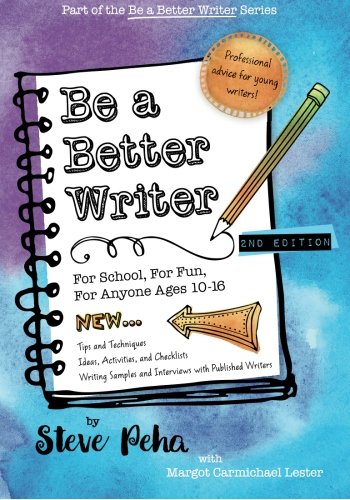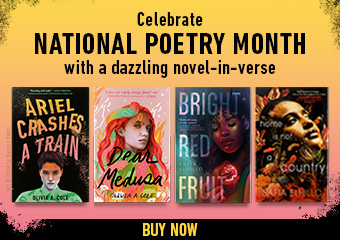All Nonfiction
- Bullying
- Books
- Academic
- Author Interviews
- Celebrity interviews
- College Articles
- College Essays
- Educator of the Year
- Heroes
- Interviews
- Memoir
- Personal Experience
- Sports
- Travel & Culture
All Opinions
- Bullying
- Current Events / Politics
- Discrimination
- Drugs / Alcohol / Smoking
- Entertainment / Celebrities
- Environment
- Love / Relationships
- Movies / Music / TV
- Pop Culture / Trends
- School / College
- Social Issues / Civics
- Spirituality / Religion
- Sports / Hobbies
All Hot Topics
- Bullying
- Community Service
- Environment
- Health
- Letters to the Editor
- Pride & Prejudice
- What Matters
- Back
Summer Guide
- Program Links
- Program Reviews
- Back
College Guide
- College Links
- College Reviews
- College Essays
- College Articles
- Back
Be a Better Writer by Steve Peha
Growing up with a love of writing, I lifted all my tricks from the books I read. All the big vocabulary words and the clever turns of phrase I copied from Lemony Snicket; I tried to mimic Madeleine L’Engle’s world-building and Sharon Creech’s emotion. Though I've had many a passionate English teacher, I still believe (as they do, too) that the best writing instructor is a piece of good writing—to write well, we have to first read.
That's why I was pleased when I first got a copy of Steve Peha’s Be a Better Writer. I heard about the book from my favorite English instructor, and I knew that even with several years of an editor-in-chief title at my school paper and a brief lifetime of writing experience, I could still “be a better writer.” Reading the book, and practicing some of the techniques it sets forth, reminded me of the stories I had read as a kid—how I'd used them as templates and guides, creating my own voice by borrowing others’.
With Be a Better Writer, I did the same. The book attacks many of the things I struggle with most and provides simple techniques to inspire breakthroughs. I often stare at a blank document for half an hour before thinking of a decent beginning to a piece: “Eight Great Ways to Lead Off With a Hit” tackles that problem with several suggestions to start my creative process. Sometimes I have trouble pinning down an idea and take too long to explain it: the Better Ideas chapter helps me recognize a good idea, then refine it. Peha presents these strategies in a helpful, rather than imposing, way. (He is so helpful, in fact, that he promises right in the book to offer help to anyone who asks for it!) He understands that writing is a very personal activity and that there is no one way to do it. So instead of presenting rigid rules, he suggests new methods and encourages readers to incorporate them into their own brainstorming and writing.
In reading this book, I've also realized that I have some good writing habits already developed. Be a Better Writer simply gives them a name and concrete steps. I already knew that I should mix up the length of my sentences to make interesting pieces, but the “10-20-30 Rule” provides a quick guide to creating variation. I have a knack for portraying a scene through sensory imagery, but the “Actions-Feelings-Settings” strategy gives me an easy way to organize details and determine which are most important. Techniques, Peha writes, “help you do complicated things faster and easier,” and learning how to write consciously with these techniques has already improved my writing process.
Peha doesn't just present lists of tools and advice. He provides examples for each strategy, including his own creative writing. The book also includes interviews from prominent and accomplished journalists, poets, and authors; I loved reading about why they got into the business and what advice they had for younger writers. Most importantly, for me, was an emphasis on the significance of my own writing. “You have a voice the world wants to hear … You have things to say that will change the way people think and feel,” reads the introduction. “The greatest power you have as a writer is the power to change yourself,” Peha writes later. I loved this message and found it so crucial to kids just striking out in the writing world. Not only do we young writers need to learn how to write, we need to understand that our words can make an impact.
Our words make the most difference when they come from a place of passion and interest. Peha understands this perfectly. Be a Better Writer helps readers find topics they care about, topics that inspire meaningful composition, topics that readers will care about, too. The book touches on the “individuality and authenticity” of good writing but also acknowledges audience and the sometimes necessary evil of writing to one. Activities like the People-Places-Things-Ideas strategy help readers hone in on what matters to them; when I tried this technique, I combined generalized topics until I had several unique and focused ones. Writing is easier and more enjoyable when we feel strongly or know much about what we write, and learning to pinpoint those topics makes us better writers.
Ultimately, that's the goal of the book, and it's a realistic guarantee: “Be a Better Writer.” It's truly a good guide, one that can be referenced and dog-eared during hundreds of writing sessions. It’s broad: it instructs on informational writing and fiction, and the techniques provided are applicable in all genres and writing styles. Topics range from grammar rules to organization tactics to giving a work personality. (Teen Ink writers will especially love the last chapter, which discusses plot twists, character development, and other things crucial to fiction writing). It's accessible: Be a Better Writer’s target is people aged 10-16, but much like young adult fiction, it can serve an audience older and larger than what’s written on the cover. The book is simple enough to be universal; teachers, parents, and older aspiring writers (like me!) can benefit from what's inside. And it's effective: reading this book provided me with new techniques, refined existing strategies, and led me to captivating topics. As I practice these skills, I'll do exactly what the cover promises and grow into the best writer I can be. It can do the same for you.
Similar Articles
JOIN THE DISCUSSION
This article has 0 comments.


Improving my writing is important to me, and I want to share what helps me.